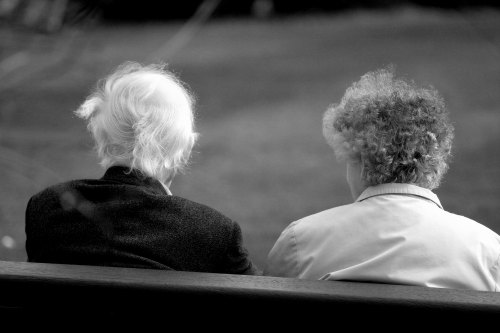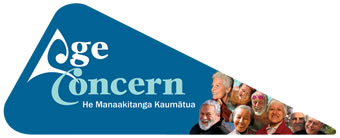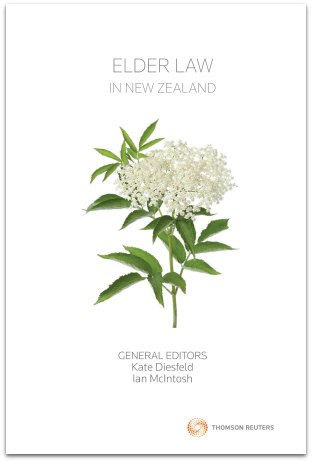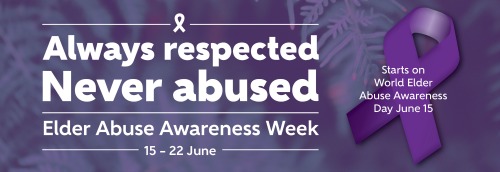Outing elder abuse
They are John, Mary, Patrick, Peter, Michael, Christine or Carol.
Carol has grab bruises on her upper arms. Christine flinches every time a door slams. John apologizes endlessly for everything – needing help to get to the toilet, having to ask for someone to help him put his shoes on …

They could be your Granny, your Granddad, your ageing aunt or uncle, cousin, sister, brother, father or mother, and frequently they are.
 Elder abuse is on the rise says Louise Collins, National Advisor for Age Concern and Elder in Law in NZ author. As our ageing population swells with the arrival of the baby boomers she predicts an epidemic.
Elder abuse is on the rise says Louise Collins, National Advisor for Age Concern and Elder in Law in NZ author. As our ageing population swells with the arrival of the baby boomers she predicts an epidemic.
This is the silent shame – the hidden secret of many families – one of the final taboos. As Louise says, we’ll discuss sexual or child abuse openly but a suggestion to acknowledge “granny bashing” triggers a chorus of denial. We do not do that.
But we do. And we do more and more of it.
Elder Abuse and Neglect Prevention Services
Most families and members of the community treat their older people well. The Elder Abuse and Neglect Prevention Services work with those who don’t.
Approximately 16% of older people who are abused come to the attention of an agency that can help
Age Concern’s Elder Abuse and Neglect Prevention Services receive on average 2000 new cases of elder abuse per year. That she says is the tip of the iceberg. The estimate is that approximately 16% of older people who are abused come to the attention of an agency that can help them. The remainder, she says, are never seen. They stay out of sight, out of mind, hidden behind the collective and convenient fiction that we play nicely with our older folk.
Louise describes the attitude as typical NIMBY – a “Not in My Backyard” response effectively blocking any suggestion that we should look more closely at why Carol is particularly prone to bruising, why Christine’s nervous response to sudden noise has intensified or why John, so staunchly and proudly independent before a recent fall now cowers mumbling sorry in his chair.
Once the protection of NIMBY is stripped away the truth about how we care for and relate to our ageing community members is far from comfortable.
Research, says Louise, shows the pattern of elder abuse in New Zealand is very similar to that in other countries and fits the accepted definition adopted from the WHO Toronto Declaration on the Global Prevention of Elder Abuse, 2002 which is:
“a single or repeated act, or lack of appropriate action, occurring within any relationship where there is an expectation of trust, which causes harm or distress to an older person.”
Elder abuse observes no boundaries; occurring regardless of ethnicity, location, socio-economic circumstances or gender
We’re not talking about random attacks she says. This is not the opportunistic bag snatcher or the thief who takes advantage of a door left wide open. Instead the perpetrator is more than likely the person responsible for an older person’s well being. It is a family member or the regular caregiver and the events themselves are often on-going. Elder abuse, she says, observes no boundaries; occurring regardless of ethnicity, location, socio-economic circumstances or gender. If a person is isolated socially or physically, dependent, unwell and lacking a regular support network they become extremely vulnerable.
Abuse can take varying forms. Louise says there are six distinct variants.
1. Psychological Abuse
Behaviour causing mental anguish, stress or fear. For example:
- ridicule or threats
- harassment or humiliation
- preventing choice or decision-making
- withholding affection.
2. Financial Abuse
Illegal or improper use of money, property or other assets. For example:
- unauthorised taking of money or possessions
- misuse of power of attorney
- failure to repay loans
- use of home and/or utilities without contributing to costs
- scams that rely on establishing a relationship with the older person with the intention of exploiting their savings and/or assets, e.g. romance scams.
3. Physical Abuse
Infliction of pain, injury or use of force. For example:
- hitting, pushing, rough handling
- over-medication
- inappropriate use of restraints or confinement.
4. Neglect
Not providing for physical, emotional or social needs. For example:
- inadequate food, clothing, shelter
- lack of social contact, support
- health needs not attended to.
5. Sexual Abuse
Non-consensual sexual acts or exploitive behaviours. For example:
- inappropriate touching
- unwanted sexual acts.
6. Institutional Abuse
A policy or accepted practice within an organisation that disregards a person’s rights or causes harm. For example:
- lack of respect for a person’s culture or customs
- inappropriate rationing of continence products
- inflexible routines e.g. breakfast at 8am in the dining room.
Why do we accept elder abuse?
The obvious question is why any form of it is tolerated?
Louise says the reasons for it not being spoken about by the abusers, the abused or its witnesses are complex.
An older person is “past their use by date”, a “waste of space”
They include deeply ingrained negative attitudes about what it is to be “old”. We belong to a world obsessed with preserving the illusion of youth for as long as possible.
To be young is good, to be middle aged is accepted with a wry smile and a defeatist shrug, but to be old… that has very few cosy connotations. An older person is “past their use by date”, a “waste of space”, "an unnecessary burden on society", "a drain on limited resources".
The penalty for aging is to be a figure of fun or ridicule - to be teased for having thin, white or grey, or no hair, a failing memory, dimming eyesight, mobility loss or any other form of increasing dependency.
The crime and shame of ageing
For many people the changes in their lives and their bodies is partnered with deep shame for succumbing to the very ordinary, inescapable and predictable process of becoming older. Their own sense of diminishing self worth and value gives rise to accepting that being despised, patronized and routinely mocked is at least to some degree expected as part of life’s journey.
If the majority perception of what it is to be old is largely negative, says Louise, then, even though abusive behavior is condemned when it is exposed, it will still persist and in some instances be construed as “normal”. This is particularly true, she says, in families where there is a history of inter-personal violence or other dysfunction.
Cultural attitudes
Cultural heritage can make it harder for both the abused and the abuser to reach out for help
Even the sectors of community who espouse and uphold a commitment to cultural values supporting the wholehearted acceptance and respect for older people are not immune to elder abuse. In New Zealand Asian, Pacific and Maori cultures in particular celebrate and value their elderly. Louise says that despite the honor accorded older family members by tradition, it doesn’t necessarily translate into the daily reality of their lives. In fact, she says, the cultural heritage can make it harder for both the abused and the abuser to reach out for help. As an example she cites the increasing numbers of abandoned elderly who initially migrated to NZ to assist their families with child minding. She says the kids grow up, or the family moves to another area without the parents because they are no longer useful and suddenly the grandparents find themselves completely isolated. They often have limited or no English. They are not NZ citizens and therefore are not entitled to support. Neither can they return to their homeland as they sold up all their assets to make the shift.
The commonest forms of elder abuse
The most prevalent of the six forms of abuse are psychological and financial followed by physical abuse and neglect.
If you love me, give me your money
Louise reports that psychological and financial abuse are frequently coupled. She says her agency is seeing a marked increase in cases where a family member is being pressured to part with significant chunks of their life savings, or to sell off their assets, in order to purchase a house or support a business.
There is a very fine line between helping a family member out freely and coercion bordering on blackmail
Pressure like this puts the older person in an invidious position. Generally they want to help their children financially and this is normal and commendable. But, says Louise, there is a very fine line between helping a family member out freely and coercion bordering on blackmail. She’s had some cases where the older person has been threatened with never seeing the grand children if they don’t hand over the money and she’s seen many more where a person has denied themselves medical attention, replacement glasses, dental care and even mobility aids in order to comply with money demands.
The possible perils of parental loans & inter-generational living
Louise is particularly concerned that banks and the media are increasingly “talking up” parental loans. She says they are setting up and reinforcing expectations that older people don’t need their own money and that it “should” be given to the younger generation with very few strings attached.
Her agency sees what happens when those loans go awry.
She counsels caution. These loans, she says, are typically the last to be paid back, if ever.
Other scenarios involve elderly re-mortgaging to raise a deposit for child’s new home, or going guarantor to support a business venture. Both of these can result in loss of their own homes. When that goes, so does their security. This is a blow, she says, most never recover from.
Another variation is inter-generational living. Often, she says, there is an expectation that Mum and Dad will sell the family home. The money will be put into the children’s home and Mum and Dad will be accommodated in a Granny flat out the back. That may sound ideal, and can work very well for everyone, but what happens if the family decides to move on? Again, often the parents are left with nothing.
You look like you need somebody to love
Stranger danger and the elderly is real says Louise. There are people actively looking for vulnerable and lonely older people to scam either on the net or in real life.
The internet version is likely to be in the form of promised romance. A person will carefully foster and develop a relationship until the targeted elderly person feels they’ve made a trusted friend who genuinely cares about them. Once that is achieved, they are tapped for cash. Given that the internet is global, these people can come from anywhere in the world, says Louise.
Despite a rising awareness of net based scams those targeted are quite likely to defend the person exploiting them primarily because they are lonely and they value the friendship the scammer offers.
Louise says families can avert these crises by keeping in touch. Ring, she says. Visit. It is often too late by the time the inheritance starts disappearing to reestablish trust and a meaningful relationship.
She says a similar situation occurs in an elderly person’s home community. There are, she says, people who intentionally look out for older isolated and vulnerable people with a view to making themselves an indispensible and vital part of their lives. Once in that position, in exchange for friendship and doing a few chores like purchasing the groceries they help themselves to free housing, money, valued possessions … It works because the cuckoo in the family nest has flung out a life line of companionship without which the “victim” would flounder. The older person says Louise, is often prepared to lose everything - their home, their savings, to sustain contact with the only person who genuinely appears to consistently and practically care about them.
For some people, says Louise, this is a job. She knows of cases in Auckland where the same women had a carefully managed network of elderly people they befriended.
I wish the families, too busy to be involved in the daily lives of their elders, would take a step back and look very carefully at the dynamics they are perpetuating
In most instances, those relationships only came to light when relatives began to notice either a depletion in savings, or significant possessions were missing. Then, says Louise, family members ask for help from Age Concern. She wishes the families, too busy to be involved in the daily lives of their elders, would take a step back and look very carefully at the dynamics they are perpetuating. Why is concern and attention triggered by a potential loss of inheritance rather than a desire to maintain a healthy, nurturing relationship?
Self neglect
The true measure of any society can be found in how it treats its most vulnerable members
There is one more area that Louise touches on: self-neglect. This is, she says, a form of abuse too. What does it say, she argues, about our society that we allow a small percentage of our seniors to suffer harm because they are unable or unwilling to care for themselves? When they’re visible these are the folk who turn into the equivalent of the archetypal muttering bag ladies. Regardless, she says they require health, housing, food, and clothing like anyone else. She understands the very fine line between freedom of choice and interference, but insists that we, as a society, have a responsibility to prevent harm to our most vulnerable members, including vulnerable older people. In her opinion to not do so is a form of abuse in itself.
What is Age Concern?
 Age Concern is a charitable organization working for older people in New Zealand. Its vision is for older people to live valued lives in an inclusive society. Its mission is to promote wellbeing, rights, respect and dignity for older people.
Age Concern is a charitable organization working for older people in New Zealand. Its vision is for older people to live valued lives in an inclusive society. Its mission is to promote wellbeing, rights, respect and dignity for older people.
The Elder Abuse and Neglect Prevention Service is one of the services provided by Age Concern to further these goals. There are 23 of these services provided by Age Concern throughout New Zealand and another 7 services supported by Age Concern but run by other charitable organisations.
The people providing the service are professionals, often social workers or nurses, who receive highly specialized ongoing training in line with practice standards and guidelines set by the Ministry of Social Development. Each service has a local advisory group comprising experts drawn from specialist areas e.g. health, law, finance and community agencies and the services are audited annually to ensure compliance with standards.
The Elder Abuse and Neglect Prevention Services work cooperatively with other agencies including health services, banks and the police; everyone who touches the lives of older people. They take referrals and requests for assistance from relatives, neighbours, courts, hospitals, banks, the police, and members of the community as well as from older people themselves.
Age Concern is partially funded by the Ministry of Social Development. The remainder needed to run its services effectively must be raised from within the local communities they operate in.
Commitment to elder care and funding
It is an irony, says Louise, that even though we have an aging population the level of annual funding has not moved for a decade. What are we doing? Where is the investment?
 Louise Collins contributed Chapter 21 "Elder Abuse and Neglect Prevention" to the recently released book Elder Law in New Zealand. Elder Law in New Zealand is the first multi-disciplinary treatment of matters pertaining to elder law. It brings together expert practical advice across a broad range of social and legal issues. More ...
Louise Collins contributed Chapter 21 "Elder Abuse and Neglect Prevention" to the recently released book Elder Law in New Zealand. Elder Law in New Zealand is the first multi-disciplinary treatment of matters pertaining to elder law. It brings together expert practical advice across a broad range of social and legal issues. More ...
For more about elder abuse and its prevention please visit Age Concern NZ .
